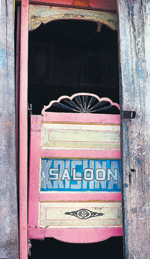|
|
||||
|
Burning bright “Sri Lanka Colour” by Dominic Sansoni. Reviewed by Professor David Robson. I first came to Sri Lanka, or Ceylon as it was then, in 1969. At that time the population was half what it is today and there was ample elbow room for ten million people to live together in a sort of imperfect harmony. I remember Colombo as a sleepy Garden City with tree screened avenues and gleaming bungalows and the rest of Ceylon as a kaleidoscope of palm fringed beaches, boulder-strewn hills, impenetrable jungles, glistening tanks, and ruined cities. But strange to relate my memories are all stored in black, white and grey. This may be because at the time I took only black and white photographs, photographs which have survived to this day on hundreds of celluloid contact strips. It may also be that my memories have been invaded by the flickering tableaux of Basil Wright’s “Song of Ceylon” which I first saw from an armchair in the Alliance Francaise in Ward Place in 1970, by the haunting images of Lionel Wendt and by the early photographs of Nihal Fernando.
It maybe also that one inheritance of Sri Lanka’s long colonial hegemony was a suppression of the senses. The British came from a cold grey island in a cold grey sea. They ate flavourless food, extolled pale skin and flaxen hair and wore beige clothes. All the colours and tastes of Sri Lanka were bottled up for four hundred years. Colour broke out for me in 1971. A friend arrived from Germany with rolls of Agfa slide film and I gave up developing films in darkened bathrooms. It was also the year when I saw my first Ena de Silva batiks at one of her verandah sales in Alfred Place and the year when I discovered Barbara Sansoni Fabrics in Anderson Road. Soon we were all parading in our bright yellow kurtas, our black and brown striped handloom trousers and our batik sarongs. And in the April of that year the insurgency shattered Ceylon’s fragile peace splattering the colour red across the map.
Barbara Sansoni didn’t invent colour in Ceylon - it was always here. But she opened our eyes to it. Her brightly woven handlooms, made with the nuns of the Good Shepherd Convent at Nayakakanda, were a revelation. In 2004 Barefoot held an exhibition to celebrate 40 years of design, colour and weaving. In its catalogue Sansoni described how her colour sense was heightened by her experiences of the landscapes and seascapes, the flora and the fauna of Sri Lanka. In a series of remarkable paired images, photographed by her son Dominic, she demonstrated how her colour combinations were drawn from nature: peacocks flying in Yala, hill terraces, the back of the bamboo forest, the striped squirrel fish. Dominic could be said to have done for photography what his mother did for weaving. His first major book, “Sri Lanka, The Resplendent Isle” produced with Richard Simon and published by Times Editions Singapore in 1989, was a pictorial compendium which also celebrated the intensity of Sri Lanka’s colours: the saffron yellow of a sleeping Buddha, the topaz blue of the lattice screens in Messenger Street, the emerald green of a hillside of tea, the blue green of the southern ocean at Weligama, the blood red of a carved Ravana head on a temple chariot in Jaffna, the pale mauves and yellows of lotus blossoms. Now Dominic has again teamed up with Richard Simon to produce a book which focuses exclusively on colour. And unlike so many books of the genre this is an entirely Sri Lankan production. The book has been beautifully designed by Nelun Harasgama Nadaraja and superbly reproduced by Gunaratne Offset Ltd. The photographs have been left to speak for themselves and the pithy captions give just sufficient information in a near invisible Gill Sans font. There are no discernable themes, no hidden messages. The images are allowed to breathe: some stand alone facing a blank page, some are double spreads, some are casually juxtaposed with other images. This is a beautiful book, beautifully made and filled with beautiful pictures. The yellow of the paper cover is the quintessential Sri Lankan colour, the colour of turmeric, the colour of a monk’s robes, but its black and red lettering aptly recall the wrapping of a Kodak film roll. The hardback within is an intense chilli red which burns the eyes. Sansoni records the ordinary objects of everyday Sri Lanka. He challenges you to go out into your garden, to walk down your street, to go to your market and experience the sheer intensity of the colours which are all around you, the colours of nature and the colours of man. In Sri Lanka the sun cuts a relentless near vertical arc across the sky. The first light of sunrise fills the world with a pale yellow hue, the midday sun burns down with a searing white intensity and the evening sun paints a warm orange glow on everything it touches. Sansoni’s pictures record the changing light and invoke the changing moods of the days and seasons. My own favourites are of people: the women of Uddapuwa in their multi-coloured saris, the devotees at Kataragama, a young lady in Jaffna, but there are also images of buildings, of landscapes, of flowers and fruit.
Over the past twenty years Sansoni has painstakingly recorded the miseries and horrors of the civil war and in his introduction Richard Simon wonders why he has not included any of those pictures in this collection. Ironically the book was conceived during that false dawn of peace which has so recently evaporated but it is being published at a moment when the threat of renewed war looms large again. Sansoni offers us a succession of pictures which are intended to please the eye and fire the imagination, pictures which help us all to see beauty in the commonplace things which surround us and remind us that life goes on in spite of everything. They serve as a hymn to peace rather than a litany of the horrors of war. (Available at Barefoot Bookshop at a special introductory price of Rs. 4,000 until August 3, after which it will be sold at Rs. 4,800) |
||||
Copyright © 2006 Wijeya Newspapers
Ltd. All rights reserved. |


